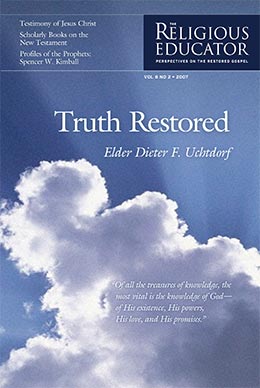Profiles of the Prophets: Spencer W. Kimball
Matthew O. Richardson and Timothy G Merrill
Matthew O. Richardson and Timothy G. Merrill, “Profiles of the Prophets: Spencer W. Kimball,” Religious Educator 8, no. 2 (2007): 131–141.
Matthew O. Richardson was an associate professor of Church history and doctrine at BYU when this was written.
Timothy G. Merrill was an instructor of religious studies at BYU when this was written.
Spencer Woolley Kimball was born on March 28, 1895, in Salt Lake City. He is the sixth child of Andrew and Olive Woolley Kimball. Olive’s patriarchal blessing promised her, “Thy sons shall be stars of the first magnitude in thy crown and . . . vigorous in helping to direct the purposes of God in this last dispensation.”[1] This blessing proved true as Spencer W. Kimball, small in stature but mighty in faith, inspired the Church to lengthen its stride and broaden its vision.
Roots in Arizona
When Spencer was three, the First Presidency called his father to serve as president of the St. Joseph Stake in Arizona. Andrew and Olive moved their family of eight from a comfortable home in Salt Lake City to Thatcher, Arizona, in the fertile Gila Valley, where they settled on ten acres of land purchased by the stake.
Although Spencer later joked of being “the laziest boy that ever lived” and of being “allergic to running except in play,”[2]
he developed a deep-rooted work ethic as he participated in the family chores of feeding hogs, milking cows, hauling hay, and irrigating crops. His father was a man of precision who required the very best from his sons. This work ethic ingrained in Spencer a duty to always do his finest work. Although Andrew Kimball was strict, Spencer greatly admired his father, who he believed was the most important man in Arizona, and consciously tried to emulate him by developing traits such as faith, frugality, integrity, and industry.
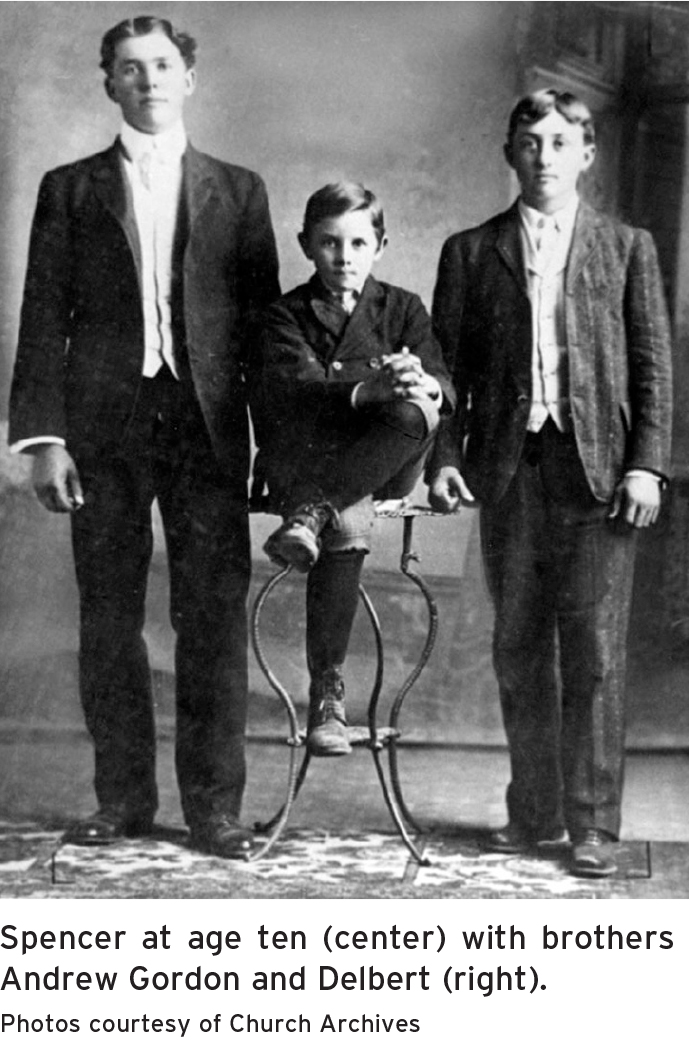
Spencer was a good-natured youth, and, according to his older brother, “everybody liked Spencer.”[3] His childhood years were not easy because they were filled with trying experiences that tempered his character and developed spiritual devotion, firm faith, and testimony. At an early age, Spencer had many opportunities for spiritual growth. He witnessed the power of fasting when his stake fasted for rain for their parched crops, he learned of receiving guidance after offering sincere prayers of need, and he witnessed the power of the priesthood as his father pronounced a priesthood blessing on a young neighbor boy who was miraculously healed.
Throughout Spencer’s youth, he had many physical trials and was even spared from death on several occasions. For example, at the age of seven, he nearly drowned while swimming in a pond before his father pulled him to safety. Before age ten, he contracted Bell’s palsy, which paralyzed the muscles in his face for months before he finally recovered. Several years later, he contracted typhoid fever, which required seven weeks to restore his health. Little did Spencer realize that he would face even more physical challenges and be spared from further life-threatening circumstances throughout his life. Other challenges forged the character of Spencer. His sister Fannie died on his ninth birthday, and two years later, Olive Kimball passed away. The Kimball home felt empty without their mother, and Spencer’s thirteen-year-old sister, Ruth, dropped out of school so she could tend the house and young children full time. Spencer called Ruth their “angel-mother.” Shortly after his mother’s funeral, Spencer’s two-year-old sister, Rachel, became critically ill with diphtheria and died.
Spencer was very active in his ward. He served as deacons quorum president and Sunday School chorister and gained a reputation for his near-perfect attendance at Church meetings. He loved singing the hymns and had a beautiful baritone voice. His father encouraged the children to learn to play the piano by allowing them to stop work in the hot afternoons and sit in the cool parlor and practice. Spencer learned to play by ear and, by the time he was fourteen, joined a band that played on the weekends to earn some spending money. Spencer was always the life of the party and delighted his friends with his quick wit and good nature—personality traits that would serve him and others well throughout his life.
Spencer attended high school at the Gila Academy, where he was elected each year as president of his school class. Not only was Spencer an excellent student but also he was the star forward on the St. Joseph’s Stake basketball team and played tennis and baseball. At Spencer’s high-school graduation ceremony, he received a shock as his father announced to the audience that his son would be serving a mission instead of starting college. Spencer readily accepted the invitation and was called to the Swiss-German Mission. Because of the pending crisis of World War I, however, Spencer was reassigned to the Central States Mission, where he served faithfully in his duties as a missionary and as the president of the East Missouri Conference.
Marriage and Professional Life
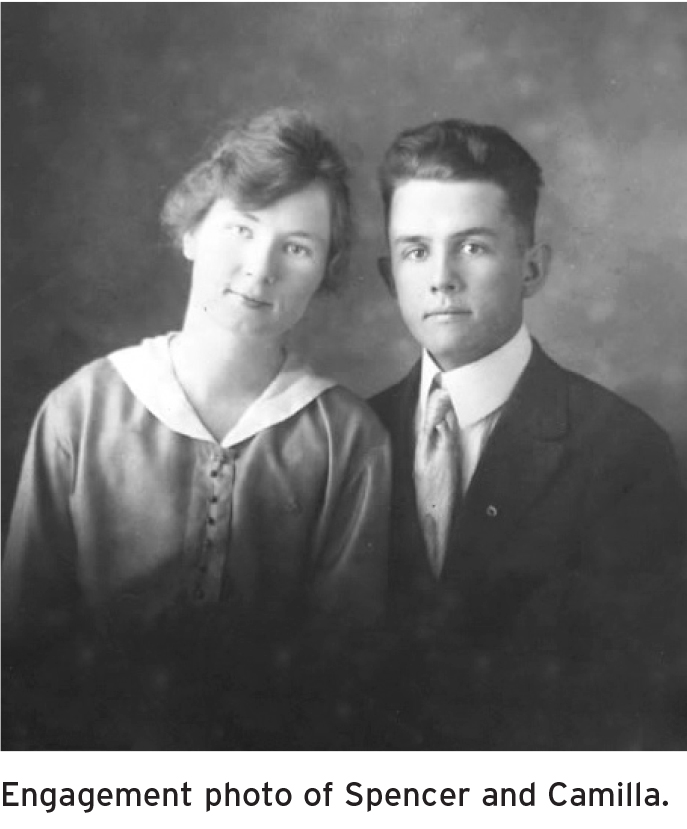
Upon returning to Arizona from his missionary service, Spencer saw a picture of Camilla Eyring, a teacher at the Gila Academy, in the newspaper. He boldly informed a friend, “That’s the girl I’m going to marry.”[4] Spencer dated Camilla for a short time before he left to study at Brigham Young University. After only four weeks at BYU, his studies were cut short because of the war draft, and Spencer returned to Arizona to prepare for military service. It didn’t take long for Spencer to court Camilla after his return home. Spencer W. Kimball and Camilla Eyring were married November 16, 1917.
Spencer worked several odd jobs until he found employment as a bank clerk. In time, Spencer and Camilla had four children: Spencer LeVan, Olive Beth, Andrew, and Edward. While raising his family, Spencer was active in his profession, his community, and the Church. After many years of working at a bank, Spencer decided to partner with Joseph Greenhalgh and form an insurance company that handled investments and real estate. Meanwhile, he remained civically active, serving on the Thatcher City Council, as Rotary club president, and later as a prestigious Rotary district governor. He also started a local radio station, served as director of the Arizona Association of Insurance Agents, and sat on the Safford City Council, the board of the Chamber of Commerce, the board of the Gila College (formerly the Academy), the board of the Red Cross, and the Arizona Teachers Retirement Board. Spencer also served as stake clerk, as second counselor in the stake presidency, and as stake president.
Call to the Apostleship
On July 8, 1943, Spencer had just arrived home for lunch when he received a telephone call from President J. Reuben Clark Jr. in Salt Lake City, who, much to Spencer’s surprise, invited him to serve in the Quorum of Twelve Apostles. On Friday, October 1, 1943, Spencer was sustained in general conference, and on October 7, 1943, he was ordained by President Heber J. Grant.
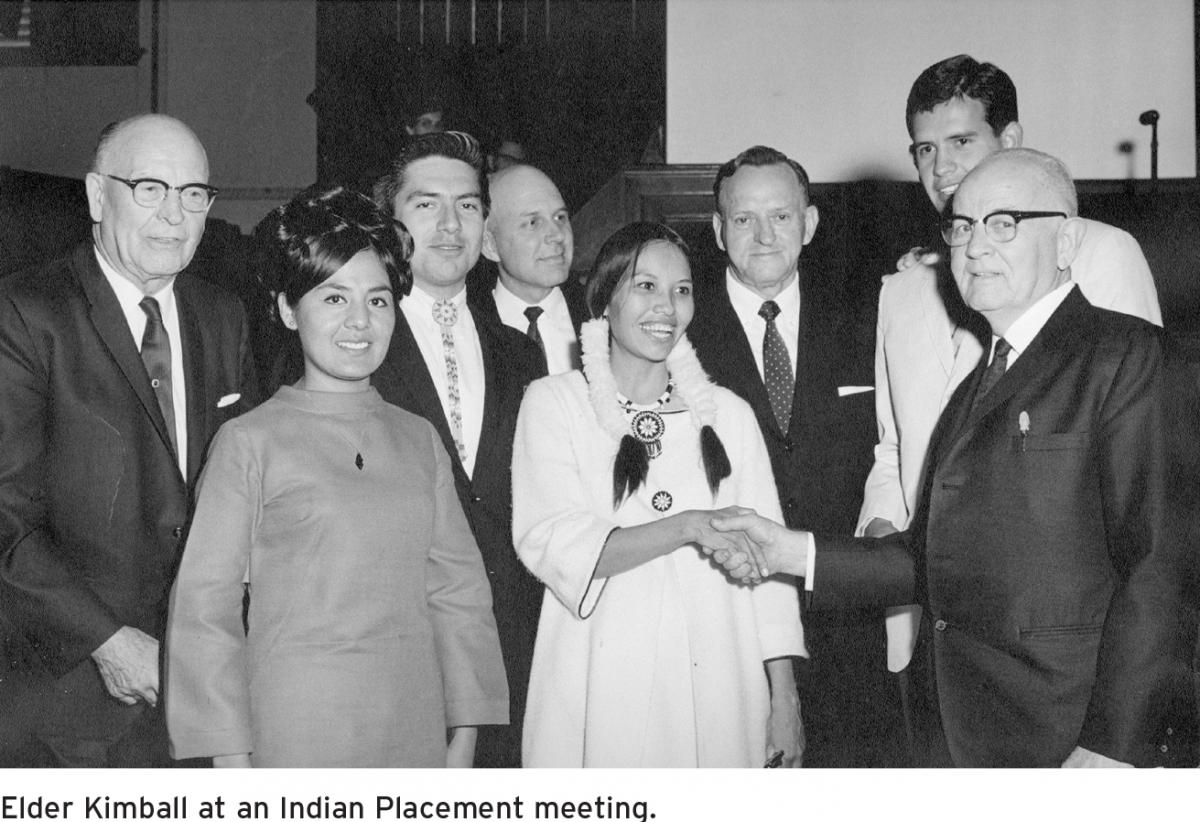
Elder Kimball’s new schedule was heavy and fast-paced. It included assignments of visiting stake conferences, designating missionary assignments, counseling individuals and couples with moral problems, and supervising missionary work in South America and Great Britain. In 1946, President George A. Smith gave Elder Kimball a special assignment to “take charge and watch after the Indians in all the world.”[5] Because Elder Kimball believed education would unlock the door of opportunity, he established Church schools on the reservations and later initiated the Indian Student Placement Program. His work among the Native Americans was tireless, and Harold B. Lee called him “the great Indian defender.”[6] Despite the pressures of his general Church responsibilities, Elder Kimball worried about staying close to his family—especially his children. He wrote in his journal of his earnest desire to be a good father: “I am trying hard to keep close to my boys and keep their love and respect and palship!”[7]
In 1959, after years of counseling troubled individuals, missionaries, and other members of the Church seeking forgiveness, Elder Kimball began to convert his notes and scriptures into an “extensive treatise on repentance.” After eight years of work, the manuscript was published as The Miracle of Forgiveness.[8] This book is still considered to be one of the most-used references on repentance.
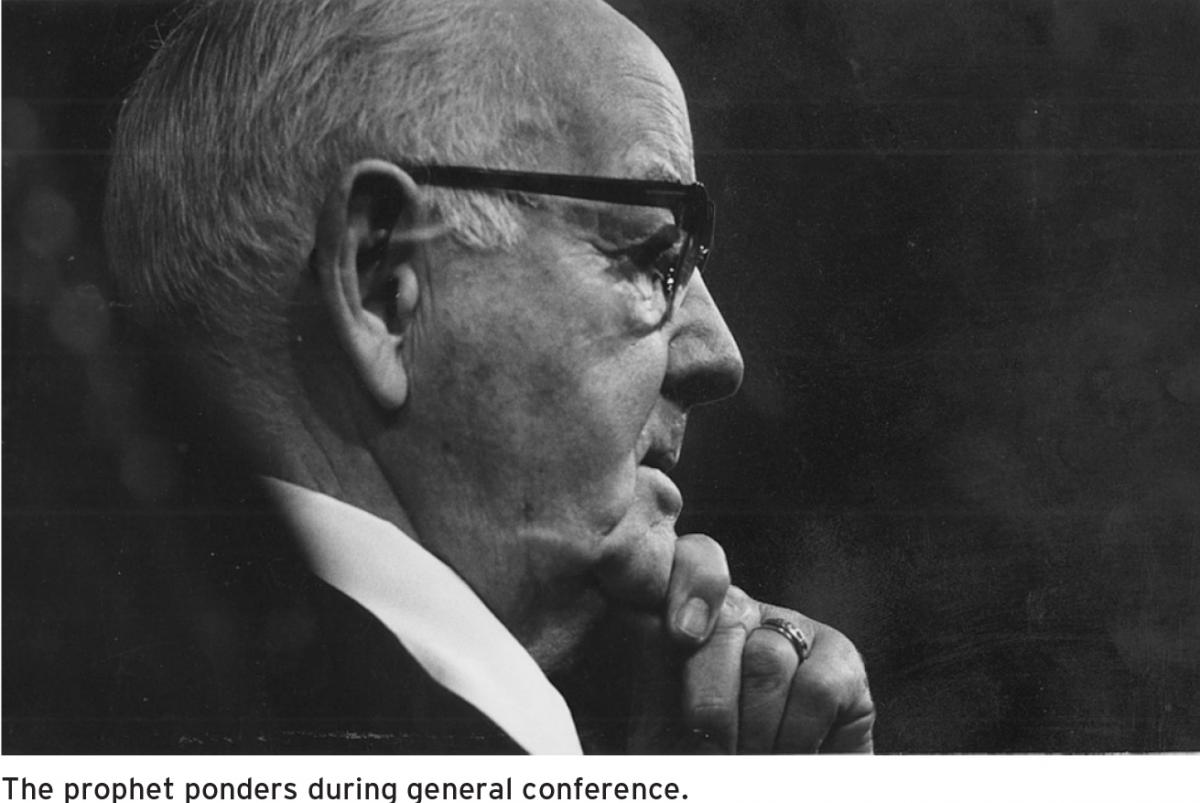
Elder Kimball’s health continued to plague him. He persevered through boils, ulcers, several heart attacks, open heart surgery, impaired hearing, and cancer of the larynx. Harold B. Lee, a fellow Apostle and a close personal friend, once said, “Spencer lives from blessing to blessing.”[9] Because of the cancer in his throat, surgeons removed most of Elder Kimball’s vocal cords in 1956, leaving him with a quiet, raspy, hoarse voice. The cancer returned fifteen years later, requiring radiation treatments. After the successful treatments, Elder Kimball began wearing a microphone attached to his glasses to amplify his weak voice. Despite his Job-like challenges, he faithfully fulfilled his assignments with determined exactness and enthusiasm.
In 1970, Elder Kimball was set apart as Acting President of the Quorum of the Twelve Apostles, and on July 7, 1972, he was set apart as President of that quorum. Seventeen months later, President Harold B. Lee died unexpectedly, and on December 30, 1973, at the age of seventy-eight, Spencer W. Kimball succeeded him as the twelfth President of the Church.
Highlights of His Presidency
President Kimball believed that the Church had a glorious destiny and fully intended to help facilitate its fulfillment. He clearly understood that if the Church were to realize this destiny, the Church and its membership could no longer be complacent. In October 1974, President Kimball taught, “So much depends upon our willingness to make up our minds, collectively and individually, that present levels of performance are not acceptable, either to ourselves or to the Lord. In saying that, I am not calling for flashy, temporary differences in our performance levels, but a quiet resolve . . . to do a better job, to lengthen our stride.”[10] The phrase “Lengthen your stride” became a favorite of the members—a motto of sorts. Sensing this, President Kimball later elaborated, “The ‘lengthening of our stride’ suggests urgency instead of hesitancy, ‘now,’ instead of tomorrow; it suggests not only an acceleration, but efficiency. It suggests, too, that the whole body of the Church move forward in unison with a quickened pace and pulse, doing our duty with all our heart, instead of halfheartedly.”[11]
The acceptance of President Kimball’s call for the Church to lengthen its stride was evident during his administration as the Church experienced unprecedented expansion in many different ways. For example, President Kimball envisioned an “army of missionaries,” which would be impossible to obtain with only a fraction of young men choosing to serve a mission.[12] Thus, President Kimball spoke in certain terms of a young man’s responsibility to serve a mission. When asked if every young man should go on a mission, he firmly responded, “The answer has been given by the Lord. It is ‘Yes.’”[13] As a result, the missionary force doubled, and fifty-one new missions were created. The number of stakes more than doubled, accommodating more than two million converts during his presidency, and the total Church membership increased from 3.3 million to 5.7 million.
In addition to the expansion of full-time missionary work, efforts to spread the gospel in other ways were implemented. Area conferences on six different continents were held, and President Kimball presided over fifty-eight solemn assemblies. Satellite technology was implemented to broadcast general conference and other training sessions throughout the world. In 1975–76, President Kimball reorganized the First Quorum of the Seventy by absorbing the Assistants to the Twelve into the First Quorum and creating emeritus status for members of advanced age in the Quorum. The unprecedented expansion included temple worship and building as well. When the use of computer technology expanded, the name-extraction program dramatically increased the need for more temple work to be done. As a result, the fifteen temples in operation when President Kimball began his administration in 1974 expanded to thirty-seven temples by 1985—a 250 percent increase. Under the direction of President Kimball, the Church published a new edition of the standard works with new study aids. The Book of Mormon was also given the subtitle “Another Testament of Jesus Christ.”
The most remarkable event during President Kimball’s administration was the announcement in 1978 extending the priesthood to all worthy males and allowing all worthy members to participate in temple ordinances.[14] President Kimball had long considered this event, and on June 7, 1978, the First Presidency and Quorum of the Twelve Apostles met in the Salt Lake Temple to fast and pray for direction. After each member of the First Presidency and Twelve had spoken, they united in formal prayer with President Kimball acting as voice. According to Elder Bruce R. McConkie, “It was during this prayer that the revelation came” and “all doubt and uncertainty fled.”[15] The revelation brought the Church closer to President Kimball’s goal of having the gospel taught throughout the world.

Throughout President Kimball’s administration, he emphasized the importance of marriage and family. “Marriage is perhaps the most vital of all decisions and has the most far-reaching effects,” he taught, “for it has to do not only with immediate happiness, but also with eternal joys.”[16] He encouraged members to work at making their marriages strong and happy, for it was his belief that “almost any good man and any good woman can have happiness and a successful marriage if both are willing to pay the price.”[17] President Kimball maintained that proper home life, good parental guidance, and proper family leadership were “the panacea for the ailments of the world, a cure for spiritual and emotional diseases, a remedy for problems.”[18] During President Kimball’s administration, family home evening was reemphasized, and the Saints were admonished to “give preference in time and energy . . . and observe properly and conscientiously the family home evening.”[19] In another move to strengthen the family, the Church consolidated the meeting schedule in 1980. President Kimball emphasized that the consolidated schedule would permit Church leaders and Church members to have more time with their family every Sunday. President Kimball urged, “Please see to it that this is done, so that you priesthood brethren do not neglect your own families and so that our wonderful stake presidents, bishops, branch and quorum presidents, and others can do likewise.”[20]
In an effort to prepare the youth for living in an environment of failing marriages and weakening moral standards, President Kimball vigorously taught the necessity of strict standards of moral cleanliness and practices that would nurture relationships and ultimately lead to worthy temple marriages. It was President Kimball, for example, who emphasized that the youth of the Church should not date before sixteen years of age.[21] He also emphasized that progression to a happy adulthood should be metered by taking “experiences in proper turn” (friendship and acquaintances, young men serving a mission, courting, and then temple marriage). President Kimball warned that “in any other sequence he [a person] could run into difficulty.”[22]
President Kimball felt that the Church’s stand on morality needed to be taught boldly. “Old values are upheld by the Church not because they are old,” he said, “but rather because through the ages they have proved right. It will always be the rule.”[23] As a result, President Kimball spoke frankly about pornography, petting, adultery, homosexuality, masturbation, and lust. His boldness was designed to warn the Saints because of the turbulent and deceitful times. “This is a most unpleasant subject to dwell upon,” President Kimball said, “but I am pressed to speak of it boldly so that no youth in the Church will ever have any question in his mind as to the illicit and diabolical nature of this perverse program.”[24]
Throughout his ministry, President Kimball stressed a model of provident living for the Saints, placing an emphasis on personal and family preparedness.[25] Such preparation included having a “year’s supply of commodities,”[26] planting and eating from a garden,[27] keeping a personal journal,[28] and even cleaning up homes and farms.[29]
In the 1970s, the Church openly opposed the proposed Equal Rights Amendment to the Constitution of the United States, feeling that the wording of the amendment would ultimately weaken both marriage and the family. As a result, President Kimball often spoke of the importance of womanhood. “Let others selfishly pursue false values,” President Kimball said, “but God has given to you the tremendous tasks of nurturing families, friends, and neighbors, just as men are to provide. But both husband and wife are to be parents!”[30]
In 1980, under the direction of President Kimball, the First Presidency issued a proclamation to the world from the Peter Whitmer Sr. home in Fayette, New York.[31] The proclamation affirmed, among other things, the reality of the Restoration of the gospel of Jesus Christ, the truthfulness of the Book of Mormon, the importance of temple work, and the divine nature of the family.
A Man of Vision
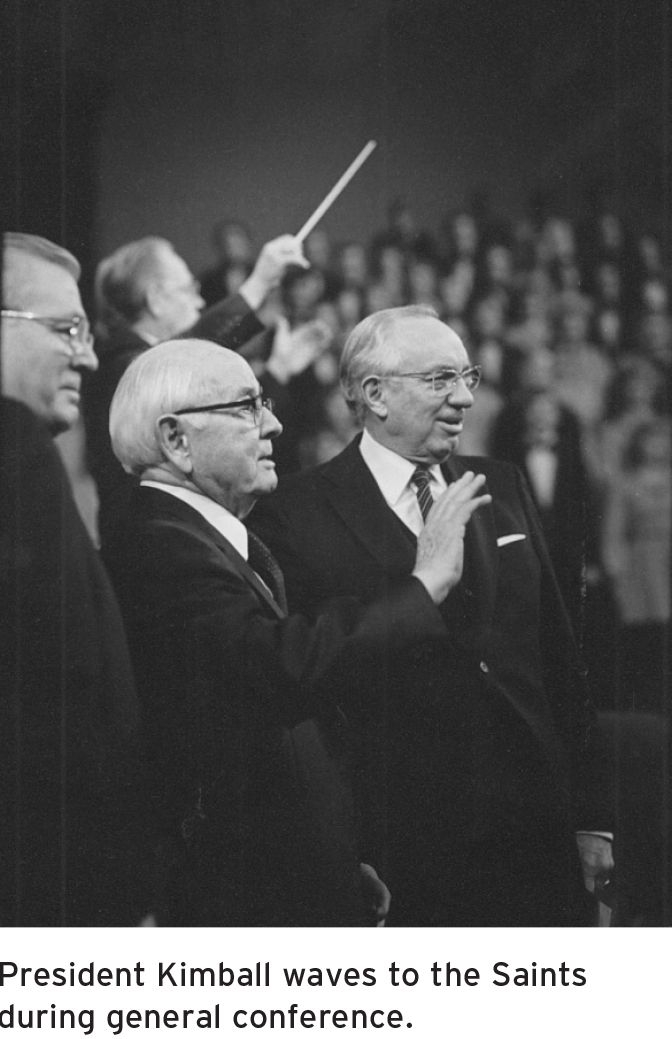
President Kimball suffered from three brain hemorrhages (1979–81) that ultimately left him unable to meet his demanding schedule. In 1981, Gordon B. Hinckley was called as an additional counselor to the First Presidency to help bear the heavy load of Presidents Kimball, N. Eldon Tanner, and Marion G. Romney, all of whom had failing health. President Kimball died on November 5, 1985, in Salt Lake City at age ninety. His wife, Camilla, died almost two years later on September 20, 1987.
President Kimball was beloved throughout the world by members and nonmembers alike. He is remembered for his sincere humility, affable wit, kindness, bold determination, and enduring work ethic. President Kimball personally emulated his own challenge of lengthening one’s stride and quickening one’s pace. He was more than a man of vision; he was a man of hard work and action. He felt that “as important as it is to have this vision in mind, defining and describing Zion will not bring it about.” He then clarified: “That can only be done through consistent and concerted daily effort by every single member of the Church. No matter what the cost in toil or sacrifice, we must ‘do it.’ That is one of my favorite phrases: ‘Do It.’”[32] It is no wonder that the Church rallied behind President Spencer W. Kimball, a man who emulated his own teachings in doing whatever the Lord asked.
Notes
[1] Ezra Taft Benson, “Spencer W. Kimball: A Star of the First Magnitude,” Ensign, December 1985, 33.
[2] Edward L. Kimball and Andrew E. Kimball Jr., Spencer W. Kimball: Twelfth President of The Church of Jesus Christ of Latter-day Saints (Salt Lake City: Bookcraft, 1977), 38.
[3] Kimball and Kimball, Spencer W. Kimball, 34.
[4] “President Spencer W. Kimball: On the Occasion of His 80th Birthday,” Ensign, March 1975, 8.
[5] Kimball and Kimball, Spencer W. Kimball, 237.
[6] Kimball and Kimball, Spencer W. Kimball, 342.
[7] Kimball and Kimball, Spencer W. Kimball, 223.
[8] Spencer W. Kimball, The Miracle of Forgiveness (Salt Lake City: Bookcraft, 1969).
[9] Kimball and Kimball, Spencer W. Kimball, 401.
[10] Spencer W. Kimball, “The Words of a Prophet,” Ensign, December 1985, 26.
[11] Spencer W. Kimball, The Teachings of Spencer W. Kimball (Salt Lake City: Bookcraft, 1982), 174–75.
[12] Spencer W. Kimball, “When the World Will Be Converted,” Ensign, October 1974, 10.
[13] Kimball, “When the World Will Be Converted,” 8.
[14] See N. Eldon Tanner, “Revelation on Priesthood Accepted, Church Officers Sustained,” Ensign, November 1978, 16–17.
[15] Bruce R. McConkie, “The New Revelation on Priesthood,” in Priesthood (Salt Lake City: Deseret Book, 1981), 128.
[16] Spencer W. Kimball, “The Importance of Celestial Marriage,” Ensign, October 1979, 3.
[17] Spencer W. Kimball, “Oneness in Marriage,” Ensign, March 1977, 4.
[18] Spencer W. Kimball, “Train Up a Child,” Ensign, April 1978, 5.
[19] Spencer W. Kimball, “A Report and a Challenge,” Ensign, November 1976, 7.
[20] Spencer W. Kimball, “Ministering to the Needs of Members,” Ensign, November 1980, 46.
[21] See Spencer W. Kimball, “President Kimball Speaks Out on Morality,” New Era, November 1980, 42.
[22] Spencer W. Kimball, “The Marriage Decision,” Ensign, February 1975, 4.
[23] Kimball, “President Kimball Speaks Out on Morality,” 42.
[24] Kimball, “President Kimball Speaks Out on Morality,” 43.
[25] See Spencer W. Kimball, “Welfare Services: The Gospel in Action,” Ensign, November 1977, 77.
[26] Spencer W. Kimball, “God Will Not Be Mocked,” Ensign, November 1974, 6.
[27] See Spencer W. Kimball, “The True Way of Life and Salvation,” Ensign, May 1978, 4.
[28] See Spencer W. Kimball, “Let Us Move Forward and Upload,” Ensign, May 1979, 84.
[29] See Kimball, “God Will Not Be Mocked,” 4.
[30] Spencer W. Kimball, “The Role of Righteous Women,” Ensign, November 1979, 103; emphasis in original.
[31] See Spencer W. Kimball, “Introduction to the Proclamation,” Ensign, May 1980, 51.
[32] Spencer W. Kimball, “Becoming the Pure in Heart,” Ensign, May 1978, 81.
